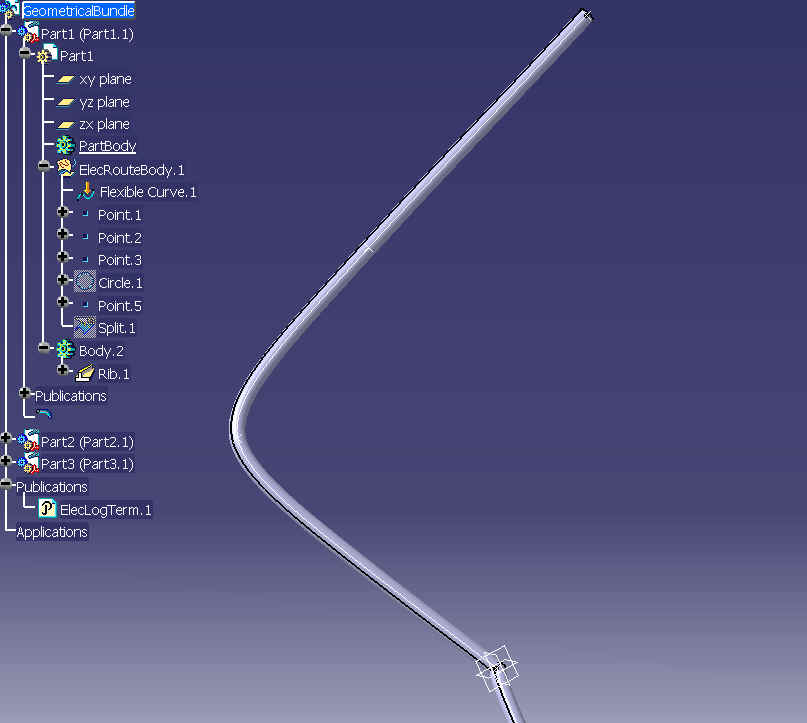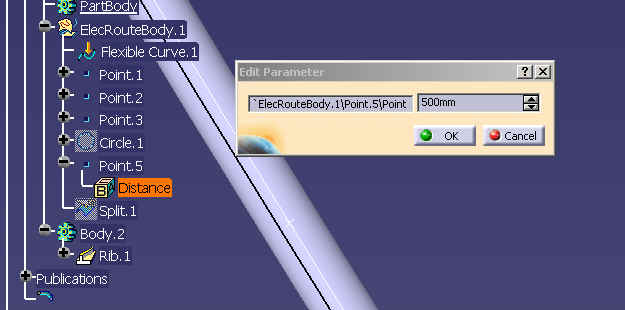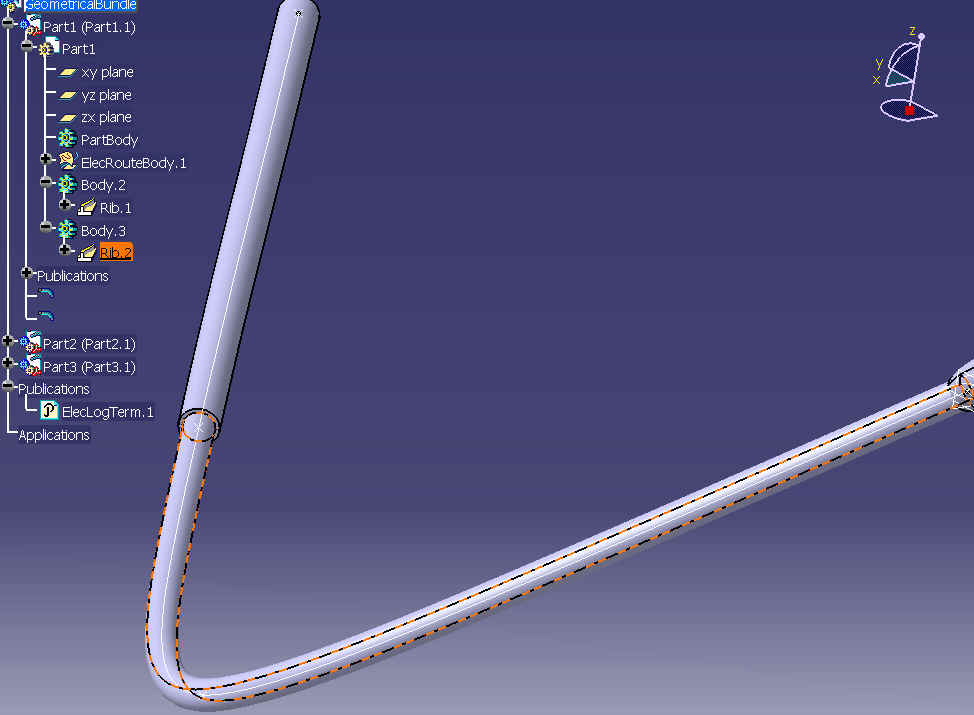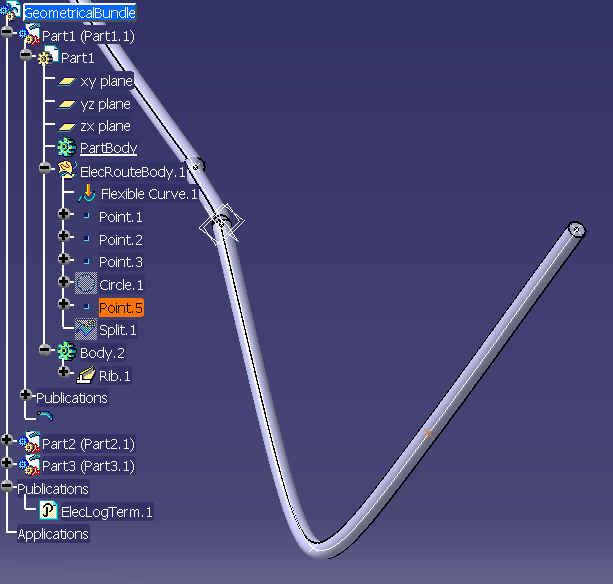
Equipment & Systems Engineering |
Electrical Harness Installation |
Managing Branchable Bundle SegmentsHow to create, split, and merge bundle segments of a branchable bundle segment |
| Use Case | ||
AbstractThis article discusses the CAAEhiCreateBranchableBundleSegment use case. This use case explains how to create a geometrical bundle, how to create a branchable bundle segment, how to split a bundle segment defined in a branchable bundle segment, and how to merge two bundle segments into one.. |
This use case is intended to show you how to create geometrical bundle and a branchable bundle segments, how split a bundle segment in two bundle segments and merge two bundle segments in one bundle segment.
Following operations are detailed is this use case:
[Top]
CAAEhiCreateBranchableBundleSegment is a use case of the CAAElecHarnessItf.edu framework that illustrates the ElecHarnessItf framework capabilities.
[Top]
The goal of CAAEhiCreateBranchableBundleSegment is to create a geometrical bundle in a new CATProduct document. branchable Bundle segments are created under geometrical bundle. Last step shows how to split and merge bundle segments.
[Top]
To launch CAAEhiCreateBranchableBundleSegment, you will need to set up the build time environment, then compile CAAEhiCreateBranchableBundleSegment.cpp along with its prerequisites, set up the run time environment, and then execute the sample. This is fully described in the referenced article [2].
To launch the use case, execute the following command:
mkrun -c "CAAEhiCreateBranchableBundleSegment PathDir GbnName Bns1Name Bns2Name Bns3Name"
[Top]
CAAEhiCreateBranchableBundleSegment code is located in the CAAEhiCreateBranchableBundleSegment.m use case module of the CAAElecHarnessItf.edu framework:
| Windows | InstallRootDirectory/CAAElecHarnessItf.edu/CAAEhiCreateBranchableBundleSegment.m |
| Unix | InstallRootDirectory\CAAElecHarnessItf.edu\CAAEhiCreateBranchableBundleSegment.m |
where InstallRootDirectory is the root directory of your CAA V5
installation. It is made of a unique source file named CAAEhiCreateBranchableBundleSegment.cpp.
[Top]
There are seven main logical steps in CAAEhiCreateBranchableBundleSegment:
We will now comment each of those sections by looking at the code.
[Top]
Once the current session has been created, the CATProduct document is created into the session . pGbnDoc is a pointer to this document.
The root product of the document is retrieved . piRootProduct is a CATIProduct handle to the root product .
Methodology describing how to create a CATProduct document and how to retrieve the root product is described in [1].
[Top]
... CATIEleDocServices * piElecDocServices = NULL;
rc = pDoc->QueryInterface(IID_CATIEleDocServices,(void**) &piElecDocServices );
if ( SUCCEEDED(rc) && piElecDocServices )
{
rc = piElecDocServices->Initialize();
}
...
|
Initializing the electrical environment is mandatory to enable access to electrical objects or electrical attributes .
[Top]
Geometrical Bundle is created using CATEhiFactory interface on root product piRootProduct.
... CATIEhiGeoBundle * piGeoBundle = NULL; // the geometrical bundle // CATIEhiFactory * piEhiFactory = NULL; // the factory // rc = piRootProduct->QueryInterface(IID_CATIEhiFactory,(void**) &piEhiFactory ); // ... rc = piEhiFactory->CreateGeometricalBundle(&piGeoBundle); ... |
piGeoBundle is the pointer to geometrical bundle.
[Top]
First step is the creation a multi branchable bundle
A new CATPart document is created and added into the product structure.
... CATIEhiMultiBranchable * piMultiBranchable = NULL; rc = piGeoBundle->CreateMultiBranchable (& piMultiBranchable ); ... |
A branchable with a bundle segment are created.
Second step is the creation of three bundle segments.
The first bundle segment has been created with the branchable.
... CATIEhiBranchable* piNewBranchable=NULL; rc = piMultiBranchable->AddBranchable(&piNewBranchable); ... rc = piMultiBranchable->AddBranchable(&piNewBranchable); ... |
Two new branchables with two bundle segments are created under the multi branchable.
Third step is the retrieving the three bundle segments under the multi branchable.
... CATListValCATBaseUnknown_var* pListBundleSegment = NULL; rc = piMultiBranchable->ListBundleSegments(&pListBundleSegment); ... CATIEhiBundleSegment * piBundleSegment1 = NULL; CATIEhiBundleSegment * piBundleSegment2 = NULL; CATIEhiBundleSegment * piBundleSegment3 = NULL; rc = (*pListBundleSegment)[1]->QueryInterface(IID_CATIEhiBundleSegment,(void**) &piBundleSegment1); ... rc = (*pListBundleSegment)[2]->QueryInterface(IID_CATIEhiBundleSegment,(void**) &piBundleSegment2); ... rc = (*pListBundleSegment)[3]->QueryInterface(IID_CATIEhiBundleSegment,(void**) &piBundleSegment3); ... |
Fourth step is the definition of bundle segment computation parameters .
Bundle segment centre curve is computed according geometrical parameters ( minimum bend radius, constraint points, tangency constraints ) and physical parameter ( gravity)
Two design methodologies are available : distributed slack or length mode.
Following attributes have to be defined :
Bundle segment 1 is created with Slack mode.
... double diameter, bend_radius; CATUnicodeString mode; // + set attributes for bundle segment 1 diameter = 0.025; bend_radius=0.03; mode="Slack"; rc = SetBundleSegmentAttributes ( piBundleSegment1, mode, bend_radius, diameter ); ... |
Bundle segment 2 is created with slack mode.
... // + set attributes for bundle segment 2 bend_radius=0.050; mode="Slack"; rc = SetBundleSegmentAttributes ( piBundleSegment2, mode, bend_radius, diameter ); ... |
CATIElecAttrAccess interface is used in SetBundleSegmentAttributes ( CAAEhiBundleSegment internal method ) to define bundle segment attribute values..
... HRESULT SetBundleSegmentAttributes ( CATIEhiBundleSegment * piBundleSegment, CATUnicodeString & mode,
double & bend_radius, double & diameter )
{
HRESULT rc = E_FAIL;
//
if (!piBundleSegment) return rc; // pointer not valuated : exit E_FAIL
if ( mode != "Slack" && mode != "Length" && mode != "Bend" ) return rc; // invalid mode : exit E_FAIL
// CATIElecAttrAccess * piElecAttr = NULL; rc = piBundleSegment->QueryInterface(IID_CATIElecAttrAccess,(void**) &piElecAttr ); if ( FAILED(rc) || !piElecAttr ) return rc; // Query Interface CATIElecAttrAccess failed : exit E_FAIL // CATUnicodeString attribute; // --- set build mode attribute = "Elec_Creation_Mode"; rc = piElecAttr->Set(attribute,mode); if ( FAILED(rc) ) return rc; // set attribute Elec_Creation_Mode failed : exit E_FAIL // --- set bend radius attribute = "Elec_Bend_Radius"; rc = piElecAttr->Set(attribute,bend_radius); if ( FAILED(rc) ) return rc; // set attribute Elec_Bend_Radius failed : exit E_FAIL // --- set diameter attribute = "Elec_Diameter"; rc = piElecAttr->Set(attribute,diameter); if ( FAILED(rc) ) return rc; // set attribute Elec_Diameter failed : exit E_FAIL // rc = S_OK; // piElecAttr->Release(); // release pointer piElecAttr=NULL; // reset pointer value to NULL // return rc; // exit S_OK; } ... |
Fifth step is the definition of bundle route.
Using CATIGSMFactory, points are created in bundle segment part ( points coordinates are given in MKS unit )
SetBundleSegmentRoute is a sample internal method used to create and to add points on bundle segment curve. Input of method is the bundle segment and the coordinates of the points defining bundle segment route.
... double points[9]; int nb_point = 3; // +- P0 points[0]=0.88; points[1]=-0.27; points[2]=0.47; // // +- P1 points[3]=0.47; points[4]=0.125; points[5]=-0.178; // // +- P2 points[6]=0.; points[7]=0.; points[8]=0.; rc = SetBundleSegmentRoute ( piBundleSegment1, points, nb_point ); ... |
Bundle segment curve is retrieved using CATIEhiBundleSegment::GetElecCurve and points are added to curve with CATIGSMSpline::AddPoint
... HRESULT SetBundleSegmentRoute ( CATIEhiBundleSegment * piBundleSegment, double * point_coord,
int & nb_point )
{
HRESULT rc = E_FAIL;
//
if (!piBundleSegment) return rc; // pointer not valuated : exit E_FAIL
if ( nb_point < 2 ) return rc; // number of points < 2 : exit E_FAIL;
// -- retrieving electrical curve
CATIGSMSpline * pElecCurve = NULL;
rc = piBundleSegment->GetElecCurve(& pElecCurve );
if ( FAILED (rc) || !pElecCurve ) return rc; // electrical curve not found : exit E_FAIL
// -- retrieving container
CATIContainer_var spCont; // the container
CATISpecObject_var spObj = pElecCurve;
if ( NULL_var != spObj ) spCont = spObj->GetFeatContainer();
// -- retrieving factories :
// - litteral feature factory
// - GSM factory
CATICkeParmFactory_var spCKEfacto = spCont; // litteral feature factory
CATIGSMFactory_var spGSMfacto = spCont; // GSM factory
if ( NULL_var == spCKEfacto || NULL_var == spGSMfacto )
{
pElecCurve->Release(); // release pointe
pElecCurve=NULL; // reset pointer value to NULL
return rc; // cannot retrieve factories : exit E_FAIL
}
// -- retrieving GSM Body :
//
CATBaseUnknown_var spGSMBody = NULL_var; // the GMS body
CATIPartRequest * pPartAsRequest = NULL;
CATIPrtContainer_var spPartCont = spCont;
if ( NULL_var == spPartCont ) return rc;
CATISpecObject_var spPart = spPartCont->GetPart();
if ( NULL_var == spPart ) return rc;
//
if( SUCCEEDED(spPart->QueryInterface(IID_CATIPartRequest, (void**)&pPartAsRequest)) )
{
const CATUnicodeString stdContext(" "); // Sets the context for bodies lookup
// retrieve GSM open body
CATLISTV(CATBaseUnknown_var) surfBodies; // List of GSM bodies in pPartAsRequest
pPartAsRequest->GetSurfBodies(stdContext, surfBodies);
// select first body found to create points
spGSMBody = surfBodies[1];
pPartAsRequest->Release();
pPartAsRequest=NULL;
}
if ( NULL_var == spGSMBody ) return rc; // GSM body not found
CATIDescendants_var spFather = spGSMBody;
if ( NULL_var == spFather ) return rc;
// -- create and add points to curve
//
CATICkeParm_var X;
CATICkeParm_var Y;
CATICkeParm_var Z;
CATIGSMPointCoord_var spPoint;
//
for ( int i=1; i<=nb_point; i++ )
{
X = spCKEfacto->CreateLength ( "X", point_coord[ 3*(i-1)] );
Y = spCKEfacto->CreateLength ( "Y", point_coord[1+3*(i-1)] );
Z = spCKEfacto->CreateLength ( "Z", point_coord[2+3*(i-1)] );
spPoint = spGSMfacto->CreatePoint(X,Y,Z);
if ( NULL_var != spPoint ) // --- point created
{
spFather->Append(spPoint); // add point under GSM body in tree
CATISpecObject_var (spPoint)->Update(); // compute point geometry
// --- add constraint point to electrical curve
pElecCurve->Add(spPoint);
}
else
{
// --- point creation failed
pElecCurve->Release(); // release pointer
pElecCurve=NULL; // reset pointer value to NULL
return rc; // GSM point creation failed : exit E_FAIL
}
}
//
// -- update curve geometry
spObj->Update();
//
pElecCurve->Release(); // release pointer
pElecCurve=NULL; // reset pointer value to NULL
//
rc = S_OK;
//
return rc; // exit S_OK;
}
...
|

Sixth step is the computation of bundle segment representation.
CATIEhiGeoBundle::ComputeBundleSegment is used to compute bundle segment shape ( part design RIB ). This method may be used to re-compute shape after parameter modification.
... // + compute bundle segment 1 // rc = piGeoBundle->ComputeBundleSegment ( piBundleSegment1 ); .. |
[Top]
Firstly we create a point on first bundle segment .
... CATIGSMPointOnCurve_var spGSMPointOnCurve; double distance = 0.5; rc = CreatePointOnBundleSegment(piBundleSegment1, distance,spGSMPointOnCurve); ... |
The creation of this point is defined in the following services :
... // piBundleSegment : bundle segment instance // distance : distance from first extremity // spPointOnCurve : the point created on the curve of piBundleSegment ... HRESULT CreatePointOnBundleSegment ( CATIEhiBundleSegment * piBundleSegment, double & distance,CATIGSMPointOnCurve_var & spPointOnCurve)
{
HRESULT rc(E_FAIL);
if(!piBundleSegment) return rc;
CATIGSMSpline * pGSMSpline = NULL;
rc = piBundleSegment->GetElecCurve(&pGSMSpline);
// -- retrieving container
CATIContainer_var spFeatContainer; // the container
CATISpecObject_var spObjectCurve = pGSMSpline;
if ( NULL_var != spObjectCurve ) spFeatContainer = spObjectCurve->GetFeatContainer();
// -- retrieving factories :
// - litteral feature factory
// - GSM factory
CATICkeParmFactory_var spCKEfactory = spFeatContainer; // litteral feature factory
CATIGSMFactory_var spGSMfactory = spFeatContainer; // GSM factory
if ( NULL_var == spGSMfactory || NULL_var == spCKEfactory )
{
if(pGSMSpline) pGSMSpline->Release(); // release pointe
pGSMSpline=NULL; // reset pointer value to NULL
return rc; // cannot retrieve factories : exit E_FAIL
}
CATICkeParm_var spDistance = spCKEfactory->CreateLength ( "Distance", 0.5);
CATIGSMPointOnCurve::DistanceType Type = CATIGSMPointOnCurve::Geodesic;
CATGSMOrientation Orientation = CATGSMSameOrientation;
spPointOnCurve = spGSMfactory ->CreatePoint( spObjectCurve,
NULL_var,
spDistance,
Orientation,
Type);
if(!spPointOnCurve)
{
cout << "> spPointOnCurve not created " << endl << flush;
return 10; // revoir le numéro a retourner
}
// -- retrieving GSM Body :
//
CATBaseUnknown_var spGSMBody ; // the GMS body
CATIPartRequest * pPartAsRequest = NULL;
CATIPrtContainer_var spPartCont = spFeatContainer;
if ( NULL_var == spPartCont ) return rc;
CATISpecObject_var spPart = spPartCont->GetPart();
if ( NULL_var == spPart ) return rc;
//
if( SUCCEEDED(spPart->QueryInterface(IID_CATIPartRequest, (void**)&pPartAsRequest)) )
{
const CATUnicodeString stdContext(" "); // Sets the context for bodies lookup
// retrieve GSM open body
CATLISTV(CATBaseUnknown_var) surfBodies; // List of GSM bodies in pPartAsRequest
pPartAsRequest->GetSurfBodies(stdContext, surfBodies);
// select first body found to create points
spGSMBody = surfBodies[1];
pPartAsRequest->Release();
pPartAsRequest=NULL;
}
if ( NULL_var == spGSMBody ) return rc; // GSM body not found
CATIDescendants_var spFather = spGSMBody;
if ( NULL_var == spFather ) return rc;
spFather->Append(spPointOnCurve);
CATISpecObject_var (spPointOnCurve)->Update(); // conmpute point geometry
//
// -- update curve geometry
spObjectCurve->Update();
if(pGSMSpline) pGSMSpline->Release();
pGSMSpline = NULL;
return rc;
}
...
|

Secondly, we can split the first bundle segment in two bundle segments as follows :
... CATIEhiBundleSegment * pElecBundleSegment = NULL; rc = piBundleSegment1-> Split(spGSMPointOnCurve, pElecBundleSegment); ... |
And we compute the new bundle segment created by split functionality :
... diameter = 0.02; bend_radius=0.03; mode="Slack"; rc = SetBundleSegmentAttributes ( pElecBundleSegment, mode, bend_radius, diameter ); ... rc = piGeoBundle->ComputeBundleSegment ( pElecBundleSegment ); ... |

[Top]
We merge the two bundle segments as follows :
... rc = piBundleSegment1->Merge (pElecBundleSegment); ... |

[Top]
The four created documents are saved into the directory defined as input. Name of file is the part number.
3 bundle segment parts are saved first.
... CATIGSMSpline * pGSMFirstSpline = NULL; CATDocument * pBnsPartDoc = NULL; CATILinkableObject_var spLinkable; rc = piBundleSegment1->GetElecCurve(&pGSMFirstSpline); if( pGSMFirstSpline)
spLinkable = pGSMFirstSpline;
if (NULL_var != spLinkable) pBnsPartDoc = spLinkable->GetDocument();
... rc = CATDocumentServices::SaveAs (*pBnsPartDoc , PathOutput+Bns1File ); ... |
Geometrical bundle is saved at the end.
... rc = CATDocumentServices::SaveAs (*pGbnDoc , PathOutput+GbnFile ); ... |
Document is removed and session is deleted before exit.
... rc = CATDocumentServices::Remove(*pGbnDoc); ... rc = ::Delete_Session(sessionName); ... |
[Top]
This use case is has demonstrated how to create geometrical bundle and bundle segments, how to connect and disconnect bundle segment.
Following operations have been detailed is this use case :
Initialize method
of CATIEleDocServices.CreateGeometricalBundle
method of CATIEhiFactory.CreateMultiBranchable
of CATIEhiGeoBundle.SetValue of CATIElecAttrAccess
.ComputeBundleSegment
of CATIEhiGeoBundle.[Top]
| [1] | Adding Components to a Product Structure |
| [2] | Building and Launching a CAA V5 Use Case |
| [Top] | |
| Version: 1 [Jan 2003] | Document created |
| [Top] | |
Copyright © 2002, Dassault Systèmes. All rights reserved.